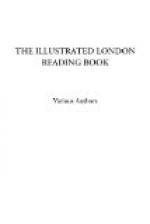[Illustration: SWALLOW PREPARING A WALL FOR HER NEST.]
[Illustration: BLACKBIRD BUILDING HER NEST.]
Such is the wonderful instinct of birds with respect to the structure of their nests. What skill and sagacity! what industry and patience do they display! And is it not apparent that all their labours tend towards certain ends? They construct their nests hollow and nearly round, that they may retain the heat so much the better. They line them with the most delicate substances, that the young may lie soft and warm. What is it that teaches the bird to place her nest in a situation sheltered from the rain, and secure against the attacks of other animals? How did she learn that she should lay eggs—that eggs would require a nest to prevent them from falling to the ground and to keep them warm? Whence does she know that the heat would not be maintained around the eggs if the nest were too large; and that, on the other hand, the young would not have sufficient room if it were smaller? By what rules does she determine the due proportions between the nest and the young which are not yet in existence? Who has taught her to calculate the time with such accuracy that she never commits a mistake, in producing her eggs before the nest is ready to receive them? Admire in all these things the power, the wisdom, and the goodness of the Creator!
STURM.
* * * * *
THE BUSHMEN.
[Illustration: Letter T.]
The Bosjesmans, or Bushmen, appear to be the remains of Hottentot hordes, who have been driven, by the gradual encroachments of the European colonists, to seek for refuge among the inaccessible rocks and sterile desert of the interior of Africa. Most of the hordes known in the colony by the name of Bushmen are now entirely destitute of flocks or herds, and subsist partly by the chase, partly on the wild roots of the wilderness, and in times of scarcity on reptiles, grasshoppers, and the larvae of ants, or by plundering their hereditary foes and oppressors, the frontier Boers. In seasons when every green herb is devoured by swarms of locusts, and when the wild game in consequence desert the pastures of the wilderness, the Bushman finds a resource in the very calamity which would overwhelm an agricultural or civilized community. He lives by devouring the devourers; he subsists for weeks and months on locusts alone, and also preserves a stock of this food dried, as we do herrings or pilchards, for future consumption.




